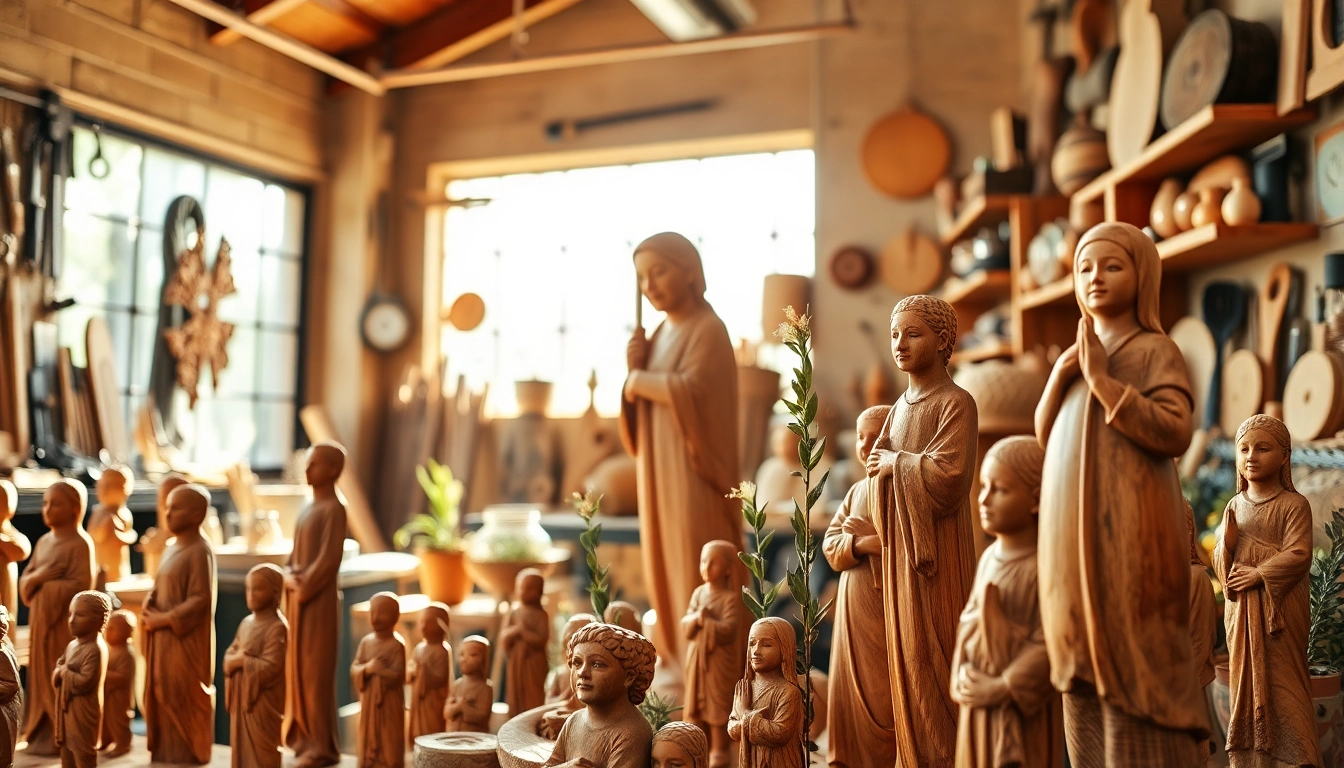
Understanding Olive Wood Carvings
Olive wood carvings hold a profound significance, deeply rooted in the culture and traditions of the Holy Land. Not only are these handcrafted pieces exquisite in their artistry, but they also present a tangible connection to history, spirituality, and craftsmanship. The allure of Olive wood carvings comes from their organic beauty and the stories they embody. Each carving serves as a reminder of the sacred olive trees from which they originate, found in the sunbathed landscapes of the Mediterranean.
History of Olive Wood Carvings
The tradition of carving olive wood can be traced back to ancient civilizations in the Mediterranean region. Olive trees, revered not only for their fruit but also for their wood, have been a part of life in these areas for thousands of years. Carving has evolved from practical tools and simple objects into a refined art form focused primarily on aesthetics and spirituality. The indigenous artisans have passed down their techniques through generations, ensuring the continuation of this rich cultural legacy.
Historically, olive wood was used for various purposes, including the crafting of religious icons, utensils, and everyday items. However, its transformation into intricate carvings emerged predominantly in Bethlehem and the surrounding areas, where artisans began creating detailed religious figures and decorative art pieces in the early 20th century. This movement not only preserved the art but also provided livelihoods for many families, fostering a community of skilled craftsmen.
The Craftsmanship Behind Olive Wood Carvings
Creating olive wood carvings requires mastery and dedication. Artisans engage in a meticulous process that begins with selecting the right piece of wood. The unique grain patterns and colors of olive wood vary, creating diverse possibilities for artistic expression. Carvers need to exhibit an in-depth understanding of wood-to-structure relationship, as they delicately chisel into the wood, bringing their vision to life.
Hand-carving is the primary method employed, utilizing traditional tools passed down through generations. The work can be painstaking but is highly rewarding. Artisans often work in small studios that provide an intimate atmosphere conducive to creativity. The time taken to produce these pieces can range from days to weeks depending on the complexity and size of the artwork.
Furthermore, the finish applied to the carvings plays a crucial role in enhancing their beauty. Often, natural oils are used, which not only condition the wood but also enhance the grain and bring out the warm tones typical of olive wood. This dedication to quality results in pieces that are not only beautiful but also durable, capable of lasting a lifetime when properly cared for.
Cultural Significance of Olive Wood Carvings
Olive wood carvings represent more than just artistic expression; they are central to the cultural identity and spiritual heritage of the region. The olive tree itself is a symbol of peace and prosperity, and its wood is often associated with divine connection. Religious figures, such as nativity scenes, crosses, and angels, are popular subjects for carving and hold significant spiritual meaning for many people.
Moreover, these carvings often tell stories from the Bible and local lore, serving as educational pieces that pass on knowledge and history. They act as tangible reminders of faith and serve as focal points in homes and places of worship. In many Christian communities, olive wood carvings have become essential gifts, especially during religious celebrations, signifying love, faith, and goodwill among friends and family.
Types and Styles of Olive Wood Carvings
Religious Olive Wood Carvings
Among the most common types of olive wood carvings are those that feature religious themes. These pieces often reflect significant biblical narratives and figures while embodying the artistic traditions of the Holy Land. From intricately carved scenes of the Nativity to beautifully rendered statues of saints, each piece is designed with precision to evoke a sense of spirituality.
Religious carvings serve various purposes. They can enhance personal altars, serve as decorative items in homes, or act as focal points in church interiors. They are also frequently gifted during religious celebrations, symbolizing blessings and prayers of the giver. Some of the most iconic items include nativity scenes that capture the birth of Jesus in exquisite detail, making them a popular choice among collectors and devotees alike.
Decorative Olive Wood Carvings
Aside from religious themes, olive wood is also used to produce decorative carvings that can be found in various forms, from small figurines to elaborate sculptures. These pieces often exploit the natural beauty and character of olive wood, taking advantage of its rich texture and color. Decorative carvings may include various themes such as animals, nature, and abstract forms, showcasing the artisan’s creativity and skill.
One popular style within decorative carvings is the creation of functional art pieces. For instance, bowls, trays, and serving platters carved from olive wood are not only visually stunning but also practical additions to any home. Each of these items carries the unique grain of the wood, ensuring that no two pieces are alike.
Custom Olive Wood Carvings
Many artisans offer the possibility of custom olive wood carvings, allowing buyers to create unique pieces that meet their specifications. This can include personalized engravings, bespoke designs to commemorate special occasions, or tailored sizes to fit specific spaces. Custom carving provides a personal touch, making it an ideal option for gifts, awards, or significant mementos.
The process of commissioning a custom piece often starts with a discussion between the artisan and the buyer, in which preferences regarding design, size, and intended use are articulated. The artisan then sketches a concept and, once approved, begins the careful carving process. This not only fosters a strong relationship with the craftsman but also infuses the object with stories and meanings unique to the buyer.
Where to Buy Authentic Olive Wood Carvings
Online Stores for Olive Wood Carvings
The rise of e-commerce has made it easier than ever to purchase authentic olive wood carvings from the comfort of your home. Numerous online stores specialize in these beautiful pieces, providing customers with a wide selection from various artisans. Shoppers can browse through different styles, sizes, and price ranges, making it straightforward to find the perfect piece.
When searching for Olive wood carvings online, it’s essential to consider factors such as the authenticity of the wood and the reputation of the seller. Look for sites that provide backgrounds on their artisans and the crafting process to ensure that your purchase supports fair trade practices and authentic craftsmanship.
Local Markets for Olive Wood Carvings
For those who prefer to see and touch the carvings before purchasing, local markets and artisan shops offer an incredible opportunity to explore olive wood carvings firsthand. Many regions, particularly those near historical sites or religious landmarks, host markets that feature local craftspeople selling their work.
Visiting these markets allows customers to appreciate the skill involved in each piece and often gives the opportunity to meet the artisans behind the work. Personal interactions can enrich the purchasing experience, offering insights into the significance and stories behind particular designs.
Choosing Quality Olive Wood Carvings
When investing in olive wood carvings, quality should be a top priority. Authentic pieces are hand-carved, showcasing unique grain patterns and details that machine-made replicas cannot replicate. To determine the quality of a carving, consider the following points:
- Artwork Details: Look for intricate designs and attention to detail in the carving. Each element should be well-defined and smooth.
- Wood Quality: Authentic olive wood has a rich, warm tone and a distinctive grain. Check for consistent color throughout the piece.
- Finish: A high-quality finish enhances the natural beauty of the wood. Natural oils are often used instead of synthetic varnishes, which can alter the appearance over time.
- Craftsmanship: Support artisans who use traditional techniques and demonstrate a commitment to preserving their craft.
By prioritizing these aspects, buyers can ensure that they acquire pieces that are not only beautiful but also authentic representations of the artisan’s skill and cultural heritage.
Maintaining Olive Wood Carvings
Cleaning and Care Tips
To preserve the beauty and integrity of olive wood carvings, proper care and maintenance are vital. Here are some essential tips:
- Regular Dusting: Use a soft, dry cloth to dust your carvings regularly, preventing dust build-up that can dull the finish.
- Cleansing: If the carvings require deeper cleaning, a slightly damp cloth can be used. Avoid soaking them in water, as excessive moisture can warp or damage the wood.
- Oiling: Periodic application of food-grade mineral oil can restore the wood’s natural luster. This is particularly important for functional items like cutting boards or utensils.
Avoiding Common Damage
Olive wood is a resilient material, but it is not immune to damage. Here are some strategies to prevent common issues:
- Humidity Control: Store your olive wood carvings in an environment with stable humidity levels. Extreme changes can lead to cracking or warping.
- Direct Sunlight: Keep carvings out of direct sunlight to prevent fading or discoloration of the wood.
- Sharp Objects: When using olive wood utensils or boards, avoid cutting with metal knives directly on the surface, as this can scratch the finish.
Restoration Techniques for Olive Wood Carvings
Even with careful maintenance, wear and tear can occur over time. Minor scratches or dullness can often be restored with simple techniques:
- Buffing: Lightly buffing the affected area with a soft cloth can sometimes remove superficial scratches and restore shine.
- Heat Treatment: In some cases, applying gentle heat can help close minor cracks. However, caution is advised to avoid overheating.
- Re-oiling: A fresh coat of mineral oil can rejuvenate the wood and enhance its natural color.
If restoration needs exceed these simple techniques, consulting a professional conservator who specializes in wooden artifacts may be beneficial.
The Future of Olive Wood Carvings
Innovations in Olive Wood Carvings
The art of olive wood carving is continually evolving. Modern artisans are increasingly experimenting with design, materials, and technology to create innovative pieces that appeal to contemporary audiences. Some are blending traditional techniques with modern design aesthetics, producing stunning contrast in their artworks.
Additions such as inlays from different woods or the combination of olive wood with metals or glass elements are becoming common. These innovative designs enhance the appeal of olive wood carvings, attracting a broader market while retaining the heritage of traditional crafting methods.
Sustainability Practices in Olive Wood Carvings
As the awareness of sustainability grows among consumers, the olive wood carving industry is adapting by adopting sustainable practices. Many artisans source wood from environmentally responsible suppliers, ensuring that their materials come from managed forests. Replanting initiatives are also becoming more prevalent, whereby each tree harvested is replaced by new growth, thereby preserving the olive tree population for future generations.
Additionally, encouraging the use of reclaimed wood from older trees that are no longer productive fosters environmentally friendly practices. This commitment to sustainability is not only beneficial for the planet but also enhances the authenticity of the carvings, as each piece tells a story of environmental stewardship.
The Growing Market for Olive Wood Carvings
The market for olive wood carvings is witnessing significant growth, fueled by increased interest in artisanal goods and handmade products. This demand is widely driven by both local buyers and international collectors looking for authentic cultural artifacts.
Moreover, the rise of e-commerce has made it easier for artisans to reach broader audiences, allowing them to share their craft with the world. As people increasingly value unique and handcrafted items over mass-produced products, the future of olive wood carvings looks promising, providing artisans and their communities with ongoing opportunities for growth and stability.






